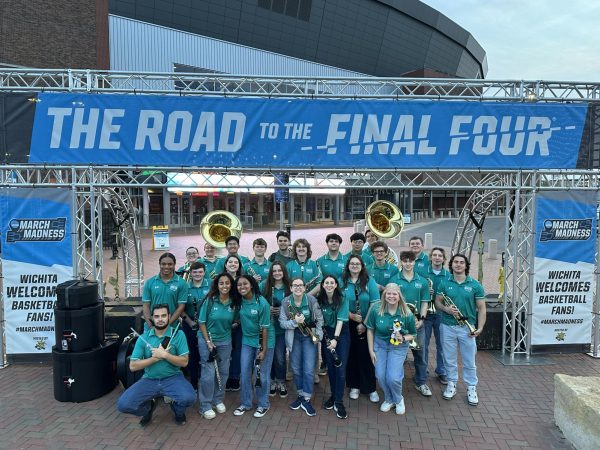Mario Bencastro: From Painting to Writing in El Salvador
“I really wasn’t trying to be a writer. I was supposed to be a painter. I was a student of geometry really and I wanted to reflect geometry, reducing all the elements of reality,” said Salvadorian author Mario Bencastro.
Bencastro, originally from El Salvador, was an award-winning painter, admittedly unconcerned with the turmoil and unrest in Central America in the 1970s, despite being born there. He spoke at UNCW this past week about his career in art and how it led him to his career in literature. With a warm smile and a thick Spanish accent, he explained that for a long time he had been content to paint and experiment with his art. He did not think of his art as any kind of political statement.
“Moving forward in my career, I went into pure abstraction. Playing with colors and forms, and not really having a meaning. I used to treat painting like a game of color and form with no real message. I used to dream about purely color and form formations and I wasn’t really thinking about any social issues. I was living in some faraway world, away from the realities that began to take place in Central America. Then I began to take some influence from the Mayan pyramids, so I guess I was getting close to where I came from – a town that is near the Guatemalan border. So even though I’m from El Salvador my ancestors come from Guatemala which is Mayan,” said Bencastro.
Bencastro identifies the influence of the Mayan pyramids as the beginning of his career in writing and the start of gradual end of his painting career started. At this point in his painting career he had already won several awards for his artwork. However, when the civil war broke out in El Salvador, Bencastro began thinking more critically about what he was doing and how his work related to his home.
“Right in 1977 is where I was probably at the peak of my (painting) career, but also in 1977 was the beginning of the social unrest back in El Salvador. And suddenly in 1979, while I was putting together a show in Washington, D.C., I overheard on the radio that there was a coup d’etat in El Salvador. So when that happened, I felt the need suddenly to look at the realities of my country. And then I began to wonder whether I could reflect that reality in my painting, because my painting is purely abstract – geometric – and it is very difficult to reflect a war, a civil war, in this composition because it does not lend itself to those realities, those social issues. So I began to think maybe I should change my style. Usually you go from representative to abstract, but I wanted to go from abstract to representational, which is backward. It’s not that easy. I wanted to tell the story of what was happening back in El Salvador.”
Bencastro was so concerned with the social unrest and the civil war that he was consumed by how he could reflect those realities in his work. He began to study great painters who had made political statements with their artwork. He eagerly studied Diego Rivera and Pablo Picasso, hoping to find inspiration so that he could follow in their tracks.
“But of course, I’m not Pablo Picasso. That’s why they say that Pablo Picasso was a genius and some painters feel that there’s nothing more you can do because he painted everything. His big painting, ‘Guernica,’ was the story of a town that was bombarded by the German Air Force, but in order for me to go from abstract to this, I didn’t even know if I could do it. So I began to experiment with writing,” said Bencastro.
Bencastro chuckled to himself as he explained his admiration for Picasso and how now, looking back, he knew his ambitions to paint like the great artist were lofty. He realized that the painting and art that he cared so much about was not the kind of form that could accurately portray what he wanted to show the world about the Salvadorian Civil War. Bencastro felt that the issues were too complex for him to paint in the geometric style he had become famous for, and this forced him into a different form of expression: writing.
“I slowly stopped painting and I went into writing. I hadn’t written anything before, and I began to write this novel, ‘Disparo En La Catedral,’ and I was learning how to write and also becoming involved in the social issues of Latin America, so as a result I wrote this very confusing novel. I submitted it to maybe 20 publishing houses and they all asked me, ‘What is this? Is it a play? Poetry? Short story? A novel? What is it? It’s very confusing and chaotic.’ And, well, the structure was chaotic because that’s what I wanted to reflect – the chaotic situation in El Salvador,” said Bencastro.
Luckily, however, Bencastro also submitted his manuscript of “Disparo En La Catedral,” or “A Shot in the Cathedral” – which took him 10 years to write – to the Diana International Literary Prize contest in Mexico in 1989. The manuscript became a finalist in the contest, won a prize, and was then first published in Mexico in 1990. The book has since been translated into English and published around the world and marked the beginning of Bencastro’s career as an author.
“And that’s how I became a writer,” said Bencastro, with a modest shrug and a quick flash of a small smile.
The night ended with Bencastro inviting UNCW students and students of UNCW’s Centro Hispano to the front of the auditorium to help him read excerpts from “Disparo En La Catedral” in both Spanish and English.







